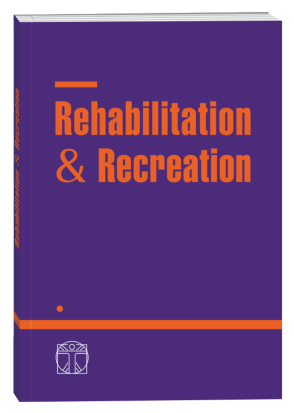COMPARATIVE ANALYSIS OF THE STATE OF PHYSICAL FITNESS OF 10-YEAR-OLD CHILDREN WITH VISUAL IMPAIRMENT IN RELATION TO THEIR HEALTHY PEERS AS A PREREQUISITE FOR THE DEVELOPMENT OF CORRECTIVE AND PREVENTIVE MEASURES
DOI:
https://doi.org/10.32782/2522-1795.2024.18.3.20Keywords:
physical fitness, children, visual deprivation, testAbstract
According to contemporary scientific research, the state of health in children with visual deprivation can be correlated with the general trend of worsening health among the entire child population. The purpose of the study – analysis of the state of physical fitness of children of 10 years with vision deprivation and determination of its differences in comparison with their peers. The study was conducted in the ЕRC “Zoresvit” Odesa, which was attended by 28 children 10-year-old, 14 children with visual deprivation and 14 children without this pathology. Research methods: theoretical analysis of data from special literature, pedagogical in the form of physical fitness testing, mathematical (central tendency, such as the mean and mode, distribution variability such as standard deviation and quartiles. Results of the study. The results showed that the values of the speed and dexterity index of children with visual deprivation when performing the shuttle run ranged from 11 to 11.5 s. with an average value equal to 11.2 s. and standard deviation – 0.17 s. (11.2±0.17). The strength indicator for the length of the standing jump varied from 138 cm to 148 cm and was (143.6 ± 3.32) cm on average. The results of the test for lifting the trunk from the initial supine position ranged from 20 to 27 times per minute with an average value of (24.1±2.03) times, and jumping rope for 20 seconds – in the range of 19 to 29 times with an average value of (23.6±3.06) times. The index of flexibility in the inclination of the trunk from the starting position while sitting forward acquired the lowest values, which were equal to 2 cm, and the highest – 8 cm, and the average score was (4.9 ± 1.98) cm. Comparing these results with school norms for performing the corresponding tests allowed to find out that according to none of the indicators, 10-year-old children with visual impairment do not achieve a high level of development of physical qualities and are inferior to their peers. Conclusions. The search for differences in the indicators of physical fitness of 10-year-old children with visual impairment from their peers without pathology revealed that they were significantly inferior to the latter in performing the proposed tests that require the development of speed, dexterity, endurance and flexibility.
References
Bukhovets B.O., Romanenko S.S., Pokropyvnyy O.M. (2023). Osoblyvosti fizychnoho rozvytku u ditey z depryvatsiyeyu zoru [Peculiarities of physical development in children with visual impairment]. Rehabilitation & Recreation, 14, pp. 186–192. https://doi.org/10.32782/2522-1795.2023.14.22 [in Ukrainian].
Bukhovets B.O., Prokofyeva L.O. (2023). Do pytannya proyavu motornykh porushen u ditey iz zorovoyu depryvatsiyeyu [On the issue of manifestation of motor disorders in children with visual deprivation]. Rehabilitation & Recreation, 17, pp. 160–170. https://doi.org/10.32782/2522-1795.2023.17.20 [in Ukrainian].
Bukhovets B.O., Kashuba V.O., Dolynskyy B.T., Dyshel H.O. (2024). Morfolohichni osoblyvosti praktychno zdorovykh ditey 12 rokiv ta yikh odnolitkiv iz depryvatsiyeyu zoru [Morphological features of practically healthy 12-year-old children and their peers with visual impairment]. Naukovyy chasopys Ukrayinskoho derzhavnoho universytetu imeni Mykhayla Drahomanova, 2 (174), pp. 45–50 [in Ukrainian].
Bukhovets B.O., Prokofyeva L.O. (2023). Do pytannya proyavu motornykh porushen’ u ditey iz zorovoyu depryvatsiyeyu [On the issue of manifestation of motor disorders in children with visual deprivation]. Rehabilitation & Recreation, 17, pp. 160–170. https://doi.org/10.32782/2522-1795.2023.17.20 [in Ukrainian].
Dmytrenko K.A. (2021). Osoblyvosti zorovoho spryynyattya ditey zi znyzhenym zorom i slabozorykh [Peculiarities of visual perception of children with low vision and low vision]. Naukovyy zhurnal Khortytskoyi natsional’noyi akademiyi, 1(4), рр. 1–9. https://doi.org/10.51706/2707-3076-2021-4-10 [in Ukrainian].
Grygus I.M., Kruk I.M. (2022). Sensorna intehratsiia ditei z rannim autyzmom [Sensory integration of children with early autism]. Rehabilitation & recreation, 11, pp. 102–110. https://doi.org/10.32782/2522-179 5.2022.11.12 [in Ukrainian].
Grygus I., Nagorna O., Nogas A., Zukow W. (2019). Anthropological providing educational services to children with special educational needs. Journal of Human Sport and Exercise, 14(4), pp. 852–866. https://doi.org/10.14198/jhse.2019.14.Proc4.48.
Kashuba V., Nasrallakh Z., Demchuk S. (2014). Kharakterystyka prostorovoyi orhanizatsiyi tila ditey molodshoho shkilnoho viku zi slukhovoyu depryvatsiyeyu [Characteristics of the spatial organization of the body of children of primary school age with hearing deprivation]. Molodizhnyy naukovyy visnyk Skhidnoyevropeys’koho natsional’noho universytetu imeni Lesi Ukrayinky, 14, pp. 65–69 [in Ukrainian].
Krutsevich T.Y., Vorobyov M.I., Bezverhnya G.V. (2011). Control in the physical education of children, adolescents and young people: study guide. Kyiv, 224 p. [in Ukrainian].
Hoeg B., Moldow B., Ellervik C., Klemp K., Erngaard D., La Cour M., (2015). Danish Rural Eye Study: The association of preschool vision screening with the prevalence of amblyopia. Acta Ophthalmol, 93, pp. 322–329 [in English].
Voloshin O.R. (2023). Kharakterystyka fizychnoyi pidhotovlenosti ta fizychnoho rozvytku pidlitkiv iz porushennyam zoru [Characteristics of physical fitness and physical development of teenagers with visual impairment]. Rehabilitation & Recreation, 14, pp. 193–198. DOI: https://doi.org/10.32782/2522-1795.2023.14.23 [in Ukrainian].
Wadhwani M., Vashist P., Singh S.S., Gupta V., Saxena R., Kalaivani M., et al. (2022). Development of age appropriate vision function questionnaire for children with visual impairment (CHVI-VFQ). Indian J. Ophthalmol. 70, 930–938. DOI: 10.4103/ijo. IJO_1177_21[in English].
Woodgate R.L., Gonzalez M., Demczuk L., Snow W.M., Barriage S., and Kirk S. (2020). How do peers promote social inclusion of children with disabilities? A mixedmethods systematic review. Disabil. Rehabil. 42, 2553–2579. DOI: 10.1080/09638288.2018.1561955 [in English].
Downloads
Published
How to Cite
Issue
Section
License
Copyright (c) 2024 Bozhena Bukhovets, Hanna Titova, Svitlana Onyshchuk

This work is licensed under a Creative Commons Attribution-NonCommercial-NoDerivatives 4.0 International License.












